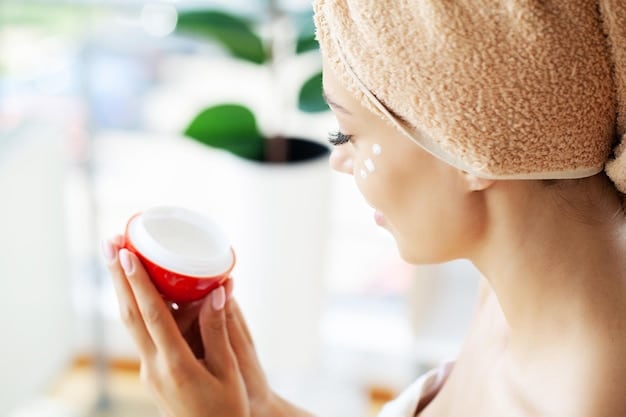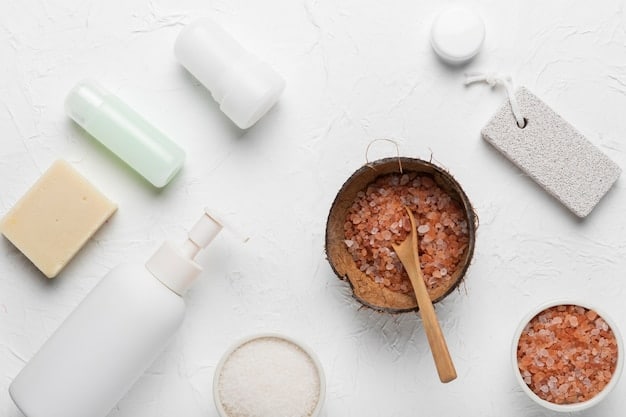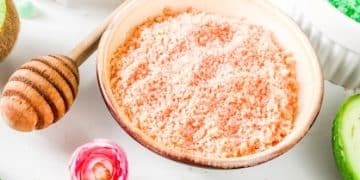Dry Skin SOS: Your Ultimate Hydrating Skincare Routine

Dry Skin SOS: A Hydrating Skincare Routine for Immediate Relief and Long-Term Results focuses on providing a comprehensive guide to combatting dry skin through targeted skincare practices, emphasizing hydration and nourishment for lasting skin health.
Is your skin feeling tight, itchy, and looking flaky? You’re not alone! Many people struggle with dry skin, especially during harsh weather conditions. But don’t despair – a well-crafted hydrating skincare routine can provide immediate relief and deliver long-term improvements. This guide, Dry Skin SOS: A Hydrating Skincare Routine for Immediate Relief and Long-Term Results, will show you how to rescue your parched skin and restore its natural radiance.
Understanding Dry Skin and Its Causes
Dry skin, also known as xerosis, occurs when your skin doesn’t retain enough moisture. This can lead to a variety of uncomfortable symptoms, including flakiness, itching, and even cracking. Understanding the underlying causes of dry skin is the first step in effectively addressing it.
Several factors can contribute to dry skin, ranging from environmental conditions to lifestyle habits. Let’s explore some of the most common culprits.
Environmental Factors
The environment plays a major role in the health of your skin. Here are some environmental factors that can contribute to dryness:
- Cold Weather: Low temperatures and low humidity during winter months can strip your skin of its natural oils.
- Harsh Weather: Exposure to strong winds and intense sun can also dry out the skin.
- Indoor Heating: Central heating systems often reduce indoor humidity, leading to dehydrated skin.
Lifestyle and Habits
Your daily habits can also significantly impact your skin’s hydration levels. Simple changes can make a big difference.
- Hot Showers and Baths: Prolonged exposure to hot water can wash away the skin’s protective oils.
- Harsh Soaps and Cleansers: Many conventional soaps contain harsh detergents that strip the skin of its natural moisture.
- Not Drinking Enough Water: Hydration starts from within. Insufficient water intake can contribute to dry skin.
Underlying Medical Conditions and Medications
In some cases, dry skin can be a symptom of an underlying medical condition or a side effect of certain medications. If you’re concerned about persistent dryness, consult a healthcare professional to rule out any potential medical issues. Common conditions linked to dry skin include eczema, psoriasis, and hypothyroidism. Certain medications, such as diuretics and retinoids, can also increase the risk of dry skin.
The Importance of Identifying Your Triggers
Recognizing the specific factors that trigger your dry skin is essential for creating a personalized skincare routine. By identifying your triggers, you can take proactive steps to minimize their impact and maintain healthy, hydrated skin.
The Core Components of a Hydrating Skincare Routine
A hydrating skincare routine is crucial for combating dry skin. It involves a strategic combination of products and practices that work together to replenish moisture, protect the skin barrier, and prevent further dryness. Let’s break down the essential components of a successful routine.
Each step in your routine should contribute to adding and sealing in moisture.

Gentle Cleansing
Cleansing is a fundamental step in any skincare routine, but it’s particularly important for those with dry skin to choose a gentle cleanser that won’t strip the skin of its natural oils. Look for cleansers that are specifically formulated for dry or sensitive skin and avoid harsh sulfates.
Ingredients like ceramides and hyaluronic acid can help retain moisture during cleansing. Always pat your skin dry with a soft towel instead of rubbing, which can cause further irritation.
Hydrating Toners and Essences
Toners and essences are often overlooked, but they can play a vital role in hydrating dry skin. These products help to balance the skin’s pH level and prepare it for better absorption of subsequent skincare products.
- Look for Ingredients: Hyaluronic acid, glycerin, and rosewater are excellent hydrating ingredients to look for in toners and essences.
- Application: Apply the toner or essence immediately after cleansing, while your skin is still slightly damp.
- Gentle Patting: Gently pat the product into your skin instead of rubbing it.
Moisturizers and Emollients
Moisturizers are the cornerstone of a hydrating skincare routine for dry skin. They work by creating a protective barrier on the skin’s surface, preventing moisture loss and providing essential hydration.
- Cream-Based Formulation: Opt for cream-based moisturizers that are richer in emollients and occlusives.
- Humectant Properties: Humectants like hyaluronic acid and glycerin draw moisture from the environment into the skin.
- Emollients: Emollients such as shea butter and squalane soften and smooth the skin.
Sun Protection
Sunscreen might not seem like a hydrating product, but it is essential for protecting dry skin from sun damage, which can exacerbate dryness and lead to premature aging. Choose a broad-spectrum sunscreen with an SPF of 30 or higher that is formulated for sensitive skin.
Consider using a physical sunscreen containing zinc oxide or titanium dioxide, as these are generally less irritating than chemical sunscreens.
Ingredient Spotlight: Hydrators and Humectants
Choosing the right ingredients is key to achieving optimal hydration and relief for dry skin. Hydrators and humectants are essential components in addressing dryness and maintaining a healthy moisture balance. Let’s delve into some of the top ingredients to look for in your skincare products.
Understanding these ingredients can help you make informed decisions about your skincare purchases.
Hyaluronic Acid
Hyaluronic acid is a powerful humectant that can hold up to 1000 times its weight in water. It works by drawing moisture from the surrounding environment into the skin, providing intense hydration and plumping the skin. This ingredient is suitable for all skin types and is particularly beneficial for dry and dehydrated skin.
Serums containing hyaluronic acid are a great way to boost hydration in your routine.
Glycerin
Glycerin is another effective humectant that is widely used in skincare products. It helps to attract moisture to the skin and create a protective barrier, preventing moisture loss. Glycerin is also known for its soothing properties, making it a great option for sensitive and irritated skin.
Look for glycerin in creams, lotions, and cleansers for added hydration.
Ceramides
Ceramides are lipids (fats) that are naturally found in the skin’s outer layer. They play a crucial role in maintaining the skin’s barrier function and preventing moisture loss. By incorporating ceramides into your skincare routine, you can help to strengthen the skin barrier, reduce dryness, and improve overall skin health.
Ceramide-rich moisturizers are ideal for repairing and protecting dry, damaged skin.
Natural Oils
Natural oils, such as jojoba oil, argan oil, and squalane, are excellent emollients that can help to soften and smooth dry skin. These oils are rich in fatty acids and antioxidants, which nourish the skin and create a protective barrier, preventing moisture loss. Choose non-comedogenic oils that won’t clog pores.
Facial oils can be used alone or added to moisturizers for an extra boost of hydration.
Building Your Personalized Hydrating Skincare Routine
Creating a personalized skincare routine tailored to your specific needs is essential for achieving optimal results. While the core components of a hydrating skincare routine remain the same, you can customize it based on your skin type, concerns, and preferences.
Here’s a step-by-step guide to help you build your own personalized routine.

Step 1: Assess Your Skin
Start by evaluating your skin’s current condition. Is it extremely dry, moderately dry, or just slightly dry? Do you have any other concerns, such as sensitivity, redness, or acne? Understanding your skin type and concerns will help you choose the right products. Note any specific triggers or ingredients that you know your skin doesn’t tolerate well.
Consider consulting with a dermatologist or esthetician for a professional skin analysis.
Step 2: Choose Gentle Cleanser
Select a gentle, hydrating cleanser that is specifically formulated for dry or sensitive skin. Avoid harsh soaps and cleansers that contain sulfates, as these can strip the skin of its natural oils. Look for cleansers with hydrating ingredients like glycerin or ceramides.
- Cream or Lotion Based: Opt for cream or lotion-based cleansers that are less drying than foaming cleansers.
- Apply Gently: Gently massage the cleanser onto your skin using your fingertips, and rinse with lukewarm water.
- Pat Dry: Pat your skin dry with a soft towel instead of rubbing.
Step 3: Apply Hydrating Toner or Essence
After cleansing, apply a hydrating toner or essence to help balance the skin’s pH level and prepare it for better absorption of subsequent skincare products. Look for toners and essences that contain hydrating ingredients like hyaluronic acid, glycerin, or rosewater.
- Apply While Damp: Apply the toner or essence while your skin is still slightly damp.
- Patting Method: Gently pat the product into your skin instead of rubbing.
- Essence Over Toner: You can use an essence in place of a toner or layer it on top for extra hydration.
Step 4: Layer Serum
Serums are highly concentrated treatments that deliver potent ingredients directly to the skin. For dry skin, choose a serum that contains hydrating ingredients like hyaluronic acid, vitamin E, or antioxidants.
Apply the serum after toner or essence, and before moisturizer. Let it absorb fully into the skin before moving on to the next step.
Step 5: Moisturize and Protect
Apply a rich, cream-based moisturizer to lock in hydration and create a protective barrier on the skin. Look for moisturizers that contain emollients like shea butter and occlusives like petrolatum or dimethicone.
If you’re using a facial oil, apply it after your moisturizer to help seal in the hydration. During the day, follow up with a broad-spectrum sunscreen to protect your skin from sun damage.
Lifestyle Tips to Support Hydrated Skin
In addition to a well-crafted skincare routine, several lifestyle factors can significantly impact your skin’s hydration and overall health. Simple changes in your daily habits can help to support hydrated skin from the inside out.
These lifestyle adjustments are crucial for complementing your skincare routine.
Stay Hydrated
Drinking enough water is essential for maintaining healthy, hydrated skin. Aim to drink at least eight glasses of water per day to keep your skin moisturized from within. Avoid excessive caffeine and alcohol, as these can dehydrate the skin.
Carry a reusable water bottle with you as a reminder to drink throughout the day.
Humidify Your Environment
Using a humidifier, especially during the winter months, can help to increase the moisture levels in your environment and prevent dry skin. Place a humidifier in your bedroom or living room to add moisture to the air.
Clean your humidifier regularly to prevent the growth of mold and bacteria.
Avoid Hot Showers and Baths
Hot water can strip the skin of its natural oils, leading to dryness and irritation. Opt for lukewarm showers and baths, and limit your time in the water. Use a gentle, hydrating cleanser and apply moisturizer immediately after showering or bathing.
Consider adding bath oils or oatmeal to your bathwater to soothe dry, itchy skin.
Eat a Balanced Diet
A balanced diet rich in essential fatty acids, vitamins, and antioxidants can promote healthy, hydrated skin. Incorporate foods like fatty fish, avocados, nuts, and seeds into your diet. Consider taking a supplement containing omega-3 fatty acids to support skin hydration.
Talk to your doctor or a registered dietitian before making significant changes to your diet or taking supplements.
Long-Term Skin Health: Consistency and Patience
Achieving long-term skin health requires consistency and patience. It takes time for skincare products to show results, and it’s important to stick with your routine even if you don’t see immediate improvements. Be patient, consistent, and persistent in your skincare efforts.
Remember that everyone’s skin is different, and what works for one person may not work for another.
- Be Patient: It can take several weeks or even months to see noticeable improvements in your skin.
- Consistent Routine: Stick to your skincare routine even when you’re busy or tired.
- Track Progress: Take photos of your skin regularly to track your progress.
Adjusting Your Routine as Needed
Your skin’s needs may change over time due to factors like seasonal changes, aging, and hormonal fluctuations. Be prepared to adjust your skincare routine as needed to address these changes. This may involve switching to a heavier moisturizer during the winter months or adding an anti-aging serum to your routine as you get older.
Consulting with a Professional
If you’re struggling to manage your dry skin or have any concerns about your skin health, consider consulting with a dermatologist or esthetician. These professionals can provide personalized advice and recommend treatments that are tailored to your specific needs.
A professional consultation can help you identify any underlying skin conditions or allergies that may be contributing to your dryness.
| Key Point | Brief Description |
|---|---|
| 💧 Intense Hydration | Use humectants like hyaluronic acid and glycerin to attract moisture. |
| 🛡️ Barrier Repair | Strengthen the skin barrier with ceramides and emollients. |
| ☀️ Sun Protection | Protect skin from sun damage with a broad-spectrum sunscreen. |
| 🌱 Lifestyle | Stay hydrated, humidify your environment, and eat a balanced diet. |
FAQ
▼
The primary cause of dry skin is the lack of sufficient moisture in the outermost layer of your skin. This can be due to environmental factors like cold weather, low humidity, harsh soaps, or underlying skin conditions.
▼
You should moisturize your skin at least twice a day: once in the morning and once at night. It’s also beneficial to apply moisturizer after showering or washing your hands to lock in moisture.
▼
Yes, diet can significantly impact your skin’s hydration. A diet rich in omega-3 fatty acids, vitamins, and antioxidants can help keep your skin hydrated and healthy. Drinking plenty of water is also crucial.
▼
Yes, many natural oils are excellent for hydrating dry skin. Oils like jojoba, argan, and squalane are rich in fatty acids and can provide a protective barrier to prevent moisture loss.
▼
You should consult a doctor if your dry skin is severe, persistent, or accompanied by symptoms like redness, swelling, or infection. It’s important to rule out any underlying medical conditions.
Conclusion
In conclusion, managing dry skin requires a combination of a consistent and well-tailored skincare routine, lifestyle adjustments, and a commitment to long-term skin health. By understanding the causes of dry skin, incorporating hydrating products and ingredients, and making informed lifestyle choices, you can achieve immediate relief and enjoy lasting comfort. Remember to consult with a skincare professional for personalized advice and to address any underlying conditions.





